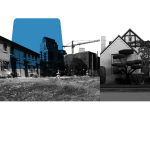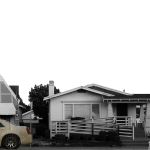The La Alma/Lincoln Park neighborhood where Mariposa is located is experiencing many changes, and not just at the former South Lincoln public housing complex. The neighborhood, which is close to downtown, now has transit-oriented developments around the light rail, bike lanes, and parks, as well as public investment in the Santa Fe arts district.
It’s no surprise then that the American Planning Association named this neighborhood one of the Great Places in America in 2014, or that the award highlighted the Mariposa redevelopment as an example of planning excellence. La Alma/Lincoln Park offers many amenities and services to its diverse residents. In a hot real estate market like Denver, this kind of neighborhood is gentrifying, leading to displacement of longtime residents.
Like a plant that’s been yanked up by its roots and is attempting to replant in new soil, people who experience abrupt and involuntary relocations struggle emotionally and physically.
Mariposa provides protected affordable housing that allows very low-income families, who are predominantly Latino and black, to stay in their community. And DHA’s work to redevelop Mariposa into a mixed-income community is not driving gentrification. But when investments and redevelopment occur without intentional efforts to be equitable or to protect affordable housing, we lose the opportunity to help low-income people and people of color stay in the vibrant neighborhoods they call home.
Limiting displacement is a health intervention. Displacement causes “root shock” — a term coined by Mindy Fullilove, MD, a professor of psychiatry at Columbia University, to describe the reaction to the loss of one’s social and emotional ecosystem. Like a plant that’s been yanked up by its roots and is attempting to replant in new soil, people who experience abrupt and involuntary relocations struggle emotionally and physically.
As part of this changing community, DHA has an opportunity. It can share what it has learned and join advocacy efforts to improve community health and prevent displacement. The Mariposa redevelopment provides a model for integrating health and community development into the process of building public and affordable housing sites. For example, health impact assessments can help design safe, stable, and affordable housing for elders, very low-income families, people of color, and people with disabilities. Below are some lessons agencies nationwide can learn from DHA’s experiences and ways DHA and other groups can take their work further.
There’s one DHA practice, in particular, that is too often missing from public sector planning: engaging with the community members who are the most unheard, and therefore the most underserved, in revitalization projects.
The Mariposa residents who participated in site design deliberations include people with extremely low income, people of color, households with children or elders, and individuals facing mental health challenges and barriers to employment. These are precisely the voices we rarely hear in neighborhood planning when we ask questions about quality of life and desired amenities.
Armed with residents’ priorities, DHA can speak directly to the importance of neighborhood integration and access to opportunities. The agency can lift up its own findings from resident engagement processes.
If health care organizations, community nonprofits, and public sector partners could see their work as a model for finding additional funds and capacity, they could infuse new energy and resources into public housing work.
For instance, it can share how diverse residents wish to see art and culture integrated in their surroundings. And DHA can contribute to institutional change by teaching other groups — such as the planning department that oversees the nearby arts district and the agency that makes decisions about cycling infrastructure — how to create and use processes that successfully engage low-income, diverse residents.
DHA has developed relationships with health care systems and social services organizations, and created models for cross-institution collaboration. Many of the practices and programs that DHA employs can benefit residents who do not live in public housing.
It may be possible to develop additional partnerships and identify funding sources that would allow more neighborhood residents to access programmatic resources available to Mariposa tenants, like health education or youth training. Or the agency can share ideas, like transit ambassadors, with other community-based organizations.
Undoubtedly, DHA is already doing more with less, and it continues to seek funds to maintain its own portfolio of work with residents. If health care organizations, community nonprofits, and public sector partners could see their work as a model for finding additional funds and capacity, they could infuse new energy and resources into public housing work.
As the neighborhood — and the city — changes and becomes less affordable, DHA staff may be able to lend their voices to housing advocacy coalitions and anti-displacement initiatives. As Michael Buonocore, the director of Home Forward, a public housing agency in Portland, Oregon, explained:
“In my observation, there are a variety of sensibilities and politics around the country about a housing authority’s role in tenant advocacy and public policy discussions. In my ideal world, our organizations would be at the table and seen as a key partner in crafting policy solutions to housing and related social issues. One of the ways we can be helpful is that we have a lot of aggregate data about households in our community who are experiencing deep poverty, who are members of communities of color, who have disabilities…. To the extent we can help define problems and add texture with anecdotal information from our service role, we could be a real asset in supporting systemic change.”
This observation provides a few insights. First, those working on affordable housing issues should view their local housing authority as a partner. Housing authorities could be brought to the table to help craft and advocate for better solutions, even in the face of grossly inadequate funding.
Second, a housing authority can be a proponent of new understanding and institutional change, based on its experiences with residents who have been displaced or who represent the most vulnerable people, including those with severe housing problems.
DHA and other housing authorities can be an important voice for low-income renters outside their tenancy lists, sharing information about who’s waiting for subsidies and speaking to the critical importance of maintaining affordable housing in place.
DHA rightly celebrates its successes at Mariposa. It also has an opportunity to use the capacity it has built to engage in the broader issues of health and housing in Denver, particularly in the context of neighborhood change and gentrification.
Lisa K. Bates, PhD, is a member of the BLOCK Project’s Community of Practice and an Associate Professor in the Toulan School of Urban Studies and Planning and Director of the Center for Urban Studies at Portland State University.


